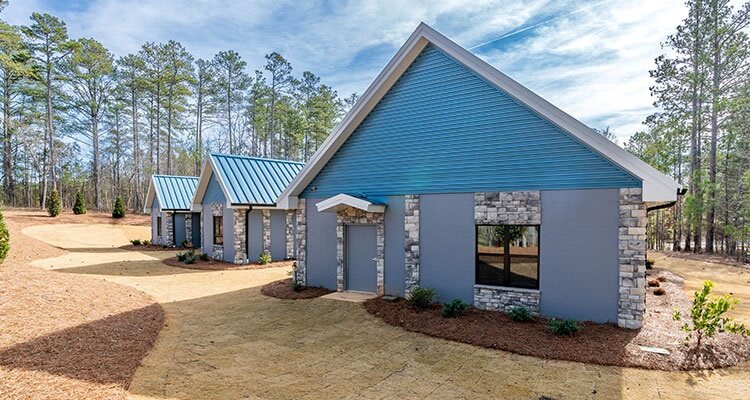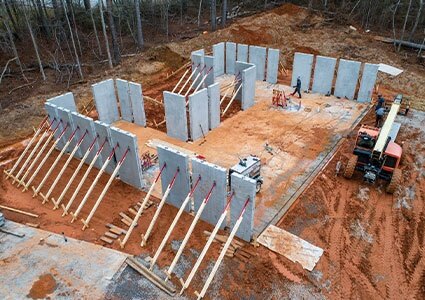Greg Rankin outlines why the trend in concrete is breaking ground, following a home insurance crisis where builders are being forced to rethink their designs
Homeowners across the US are running out of options when it comes to protecting their houses. The problem is that climate change has increased the risk of catastrophic damage due to windstorms, flooding, and wildfires. With the cost of rebuilding after a disaster rapidly increasing, insurance agencies are passing along the burden to homeowners, with no end in sight. In fact, according to a report from First Street Foundation, a nonprofit research group, almost a third of all homeowners in the lower 48 states are already struggling to find affordable insurance. Without cost-effective coverage, the housing market’s future is in peril.
 While governments and the insurance industry grapple with viable solutions, there is growing discussion as to the future of residential construction and the pursuit of a more durable alternative to wood-framed, single-family homes. This is of particular importance to those living in areas where natural disasters like hurricanes, tornadoes, and wildfires devastate thousands of wooden structures every year in the US.
While governments and the insurance industry grapple with viable solutions, there is growing discussion as to the future of residential construction and the pursuit of a more durable alternative to wood-framed, single-family homes. This is of particular importance to those living in areas where natural disasters like hurricanes, tornadoes, and wildfires devastate thousands of wooden structures every year in the US.
While looking for an advanced technology for the future, some home builders are looking to improve upon a design that has been used in other parts of the world throughout history, namely concrete. The ancient Romans and Greeks were very successful in constructing just about everything, from homes to stadiums out of concrete, some of which are still standing centuries later. There are several advantages to utilizing concrete over wood. Most notably, of course, is its durability, which greatly outperforms wood-framed homes. Additionally, unlike wood, concrete is not vulnerable to external factors like insects, moisture, mold, fire, or wind – all of which can result in structural damage and pose safety risks.
Yet, even with the advantages to utilizing concrete, there are some significant reasons for the lack of wide-spread adoption. Chief among them is the high cost of construction. Other drawbacks include concrete’s poor insulation, less appealing finishes and designs, and the added time required for construction.
However, recent innovations are not only eliminating these drawbacks, but promise a huge reduction in initial cost, making them comparable to wood-framed structures. In fact, when lifetime upkeep, insurance, and other expenses are factored in, concrete homes are expected to greatly reduce the total cost of ownership.
Driving down construction costs
“What we are seeing in the concrete industry today is incredible. The things we thought would be horribly expensive just five years ago, we’re doing every day now,” says Mark Sinicrope, Precast Specialist at Master Builders, a provider of chemical solutions for concrete construction. Mark has more than 40 years of experience working with precast and prestressed concrete products in applications ranging from bridge beams to parking garages. While most of the advancements and cost cutting to date has been on the commercial side, he is starting to see those innovations flow into residential concrete home construction. For example, Mark recently helped Texas-based Nonquit Homes with a concrete mix design used to develop tilt-up, prestressed concrete panels for residential construction.
“What they are doing is pretty much the same thing we are seeing for large-scale commercial buildings,” explains Mark. “In fact, the new Tesla plant in Austin has a very similar sandwich panel design, and they go up like a big Erector Set.”
However, the residential concept from Nonquit Homes is also aiming to eliminate some of the traditional shortcomings of commercial concrete construction. To begin with, the prestressed sandwich panels can be poured on site, thus eliminating the need to be transported in from a precast manufacturer, which reduces both cost and time.
Time
“In construction, it is all about how fast you can go,” adds Mark. “Let’s say I wanted to put up a parking garage today. We could have it up in two or three weeks, but it might take a year or more because we have to wait for someone to actually produce all those concrete panels and then ship them to the jobsite.” Costs are further trimmed by reducing the size of the panels so there is no need to bring in expensive cranes to move large panels around the jobsite. Instead, the panels can be maneuvered by forklifts, further cutting down on labor.
“I can see an entire house going up with just three or four people onsite to tilt up the panels and set them in place,” says Terrell Wiggins from Nonquit Homes, who along with engineer Alonso Forcado, designed and built the first residential home outside of Atlanta using this style of construction. “Plus, you’re not sitting there waiting on the framer or struggling to schedule all the different trades required to build the actual house. For a builder, that is huge.”
Depending on the size, a typical wood-framed home can take six months to a year to complete. However, once a builder gets going and perfects this new concrete building process, they could greatly reduce that build time.
Durability 
While the insurance crisis is illuminating the need for more durable housing, climate change will only increase the urgency. According to data from NOAA, there were 60 weather and climate-related disasters in the US from 2020 to 2022, with losses exceeding $1 billion per year. For comparison, between 1980 and 2019 the average per year was eight. Concrete homes can even withstand the extremely high winds associated with large hurricanes and tornadoes. “Today, precast can hold up to a 200 mile an hour wind load, depending on how it’s designed,” Mark explains.
However, it is often not just the straight-line wind that causes significant damage during a wind event. Shrapnel from other structures is also a major concern. As part of that, the Precast Concrete Institute (PCI) wanted to test the durability of concrete panels by pitting them against both a concrete block wall and a wooden house with brick veneer.
“They fired the two-by-fours out of an air cannon at 150 MPH at the concrete sandwich panel and the lumber shattered into toothpicks, without any damage to the panels,” adds Wiggins. “However, it blew a massive hole straight through the exterior of both the brick and cinderblock wall.”
Energy efficiency
Another area of concern being addressed by new concrete home designs is energy efficiency. While concrete is very dense and therefore airtight, it is not considered a good insulator. By incorporating a thick layer of insulation into the concrete panels, however, the energy efficiency of the home can exceed that of a traditional wood-framed home. In addition, adding the insulation into the casting process further reduces construction time and costs by eliminating the need for insulation and sheetrock along the exterior walls.
Design
Traditional concrete homes typically offered limited architectural design options. However, the concrete industry has come a long way and design choices are now almost endless with colored, patterned, and textured concrete. Additionally, you can utilize traditional exteriors such as stone, brick or stucco to add the coveted curb appeal.
Further savings
While builders can see their construction costs greatly reduced by utilizing these new methods for building concrete homes, homeowners also stand to benefit. Not only does it promise a much safer option, with lower energy consumption and fewer repairs, but there are several government and banking incentives to buying concrete as well. For instance, concrete homeowners may qualify for Energy Efficient Mortgages (EEM) allowing borrowers to qualify for a larger loan amount due to the ongoing energy savings that result in much lower energy bills.
Some of the biggest savings, however, are likely to be seen in the dramatic drop in monthly insurance premiums. Many insurance companies already offer lower rates for concrete homes because they produce far fewer claims arising from fire, wind and water damage, or pests. As insurance becomes scarce and costs surge, homebuyers will have no choice but to walk away from deals on wood-framed homes. This could be the crux for a major shift in residential home building. Especially if the right design can make sense for a home builder’s bottom line. “Like with anything else, it just takes one person to figure out a way to make it profitable and everybody will jump in,” concludes Mark. “When it comes to residential concrete homes, I think we’ve finally reached that point.”
Greg Rankin is a freelance writer based in Houston. He has more than 20 years of experience writing about construction and engineering, and the concrete sector.

